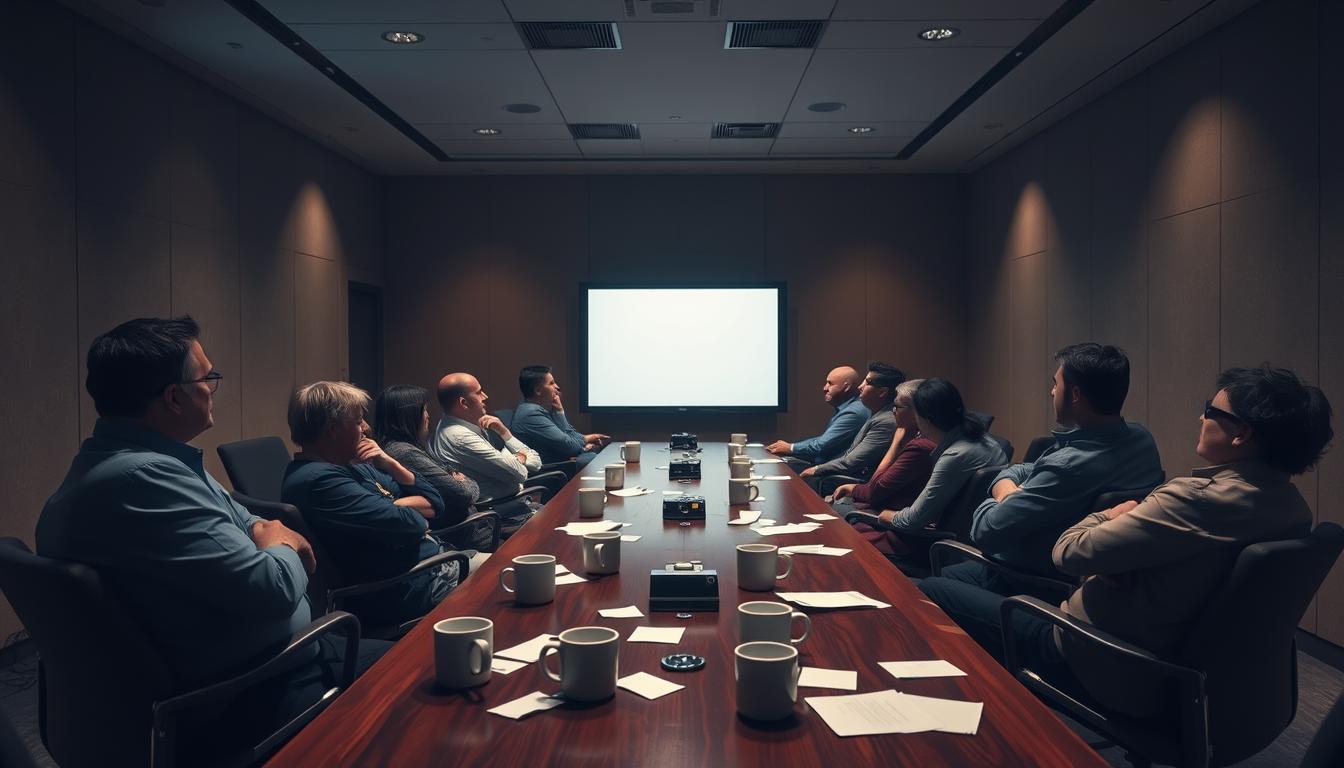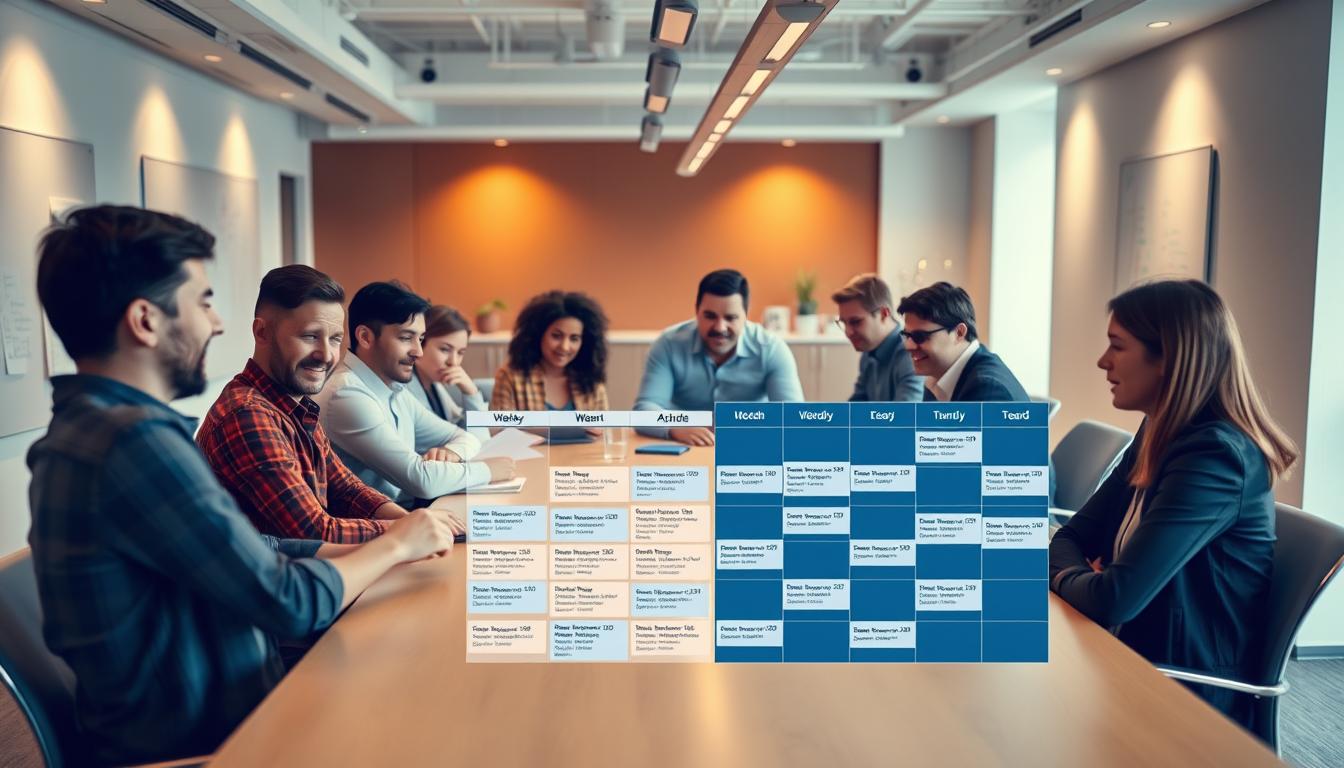Nowadays, work moves fast and making team meetings better is key for top productivity. Businesses see the need for strong meeting methods. These methods should boost involvement and help everyone work better together.
Good leadership is essential in making meetings useful. With the right methods and a clear goal, teams can make their meetings more productive. This leads to better mood and stronger teamwork.
Understanding the Importance of Meeting Efficiency
Effective meetings boost productivity and team spirit. They help teams work together and reach their goals. If done right, meetings reduce misunderstandings and make teamwork more efficient.
Impact on Productivity
Meetings are key to productivity in today’s world. Unfocused employees cost U.S. businesses over $1.9 trillion a year. This shows how crucial engaging meetings are. Without purpose, meetings waste time and lower motivation.
- Structured meetings provide clarity on roles and responsibilities.
- Effective collaboration in meetings aligns team goals with organizational objectives.
- A focused meeting atmosphere fosters improved engagement among team members.
Connection to Team Morale
Team morale is tied to how well meetings are run. About 64% of employees feel they waste three hours a week due to poor teamwork. This affects productivity and morale. Good meetings allow everyone to share ideas and concerns, creating a strong team environment.
The Role of Effective Leadership in Team Meetings
Good leadership greatly improves how a team meeting goes. A leader who sets clear goals brings everyone together. They make sure all team members understand the plan. A leader encourages everyone to take part, aiming for the best results. And when a leader talks openly and values everyone, trust grows. This makes the team close and welcoming.
Setting Clear Goals
Having clear goals is like having a map for the meeting. Leaders must make the objectives known so everyone gets the aim. This focus keeps meetings on track. Using methods like the 4 Disciplines of Execution® (4DX®) helps teams stick to what’s important. Everyone knows what they should do, boosting productivity.
Encouraging Open Communication
It’s key for teams to speak freely to work well together. Leaders need to make a space where ideas and worries can be shared without fear. This leads to better talks and new ideas. It also helps team members bond, making meetings more effective.
Team Meeting Efficiency: Key Strategies to Implement
To make team meetings work well, introducing strategies that define the meeting’s goals is essential. Having a clear purpose helps keep everyone on track and productive. Understanding the team’s objectives makes discussions and decisions more impactful.
Defining Meeting Objectives
Clear objectives set the direction and purpose of a meeting. Deciding what topics to discuss or ideas to explore comes from these goals. Think about these aspects when setting your meeting goals:
- Aligning on project timelines
- Developing strategies for problem-solving
- Making collaborative decisions
Creating Structured Agendas
Having structured agendas is key to keeping focus. A good agenda lists topics, allocates time for each, and names who leads each topic. This approach makes sure everyone is ready and boosts the meeting’s success.
Prepping for a Productive Meeting
Getting ready for meetings the right way is key to doing well in business settings. Planning ahead lets team members manage their tasks better. This means less interruptions and more people taking part. Setting clear roles keeps the meeting organized and everyone knows what they should do. This approach greatly improves how productive meetings are.
Scheduling Tips and Best Practices
Following good scheduling tips can make meetings run smoother. Here are some important strategies:
- Choose times that work for most people, avoiding very early or late times.
- Look at calendars to see when everyone is free before setting the meeting time.
- Share the agenda early, at least a day before, so people can get ready.
- Keep meetings to what’s needed, to value everyone’s time.
Roles and Responsibilities in Meetings
Having clear roles in meetings can make them more effective and focused. When everyone knows their job, things go more smoothly, leading to better results. Here are some common roles:
- Facilitator: Leads the discussion and makes sure everyone gets to speak.
- Timekeeper: Keeps track of how long each topic takes.
- Note-taker: Writes down important points and tasks that need to be done later.
Executing Meetings: Engaging Team Members
Having everyone take part in meetings is key to being productive. It’s important that team members feel they can share ideas freely. Leaders can help by using different ways to get everyone talking.
Facilitating Active Participation
To get everyone involved in meetings, you need a good plan. Here’s how to make meetings more engaging:
- Icebreakers: Begin with fun questions to get people talking and smiling.
- Interactive Tools: Use things like polls or shared whiteboards to hear from everyone.
- Open Discussions: Make sure there’s time for everyone to share their thoughts openly.
- Rotate Roles: Let different people lead or take notes to increase involvement.
By using these methods, companies build a work culture that appreciates everyone’s input. This leads to a team that works well together.
Utilizing Technology to Boost Engagement
Technology makes meetings more engaging and effective. The right tools make communication smooth and meetings efficient. It’s crucial for organization and making meetings interactive, which boosts participation.
Effective Collaboration Tools
Tools like Slack, Microsoft Teams, or Asana change how we meet. These platforms let teams share info easily, track tasks, and talk without barriers. Look for real-time messaging, calendar sync, task management, and video chat in these tools.
- Real-time messaging and file sharing
- Calendar synchronization for scheduling
- Task management integrations
- Video conferencing capabilities
Using these tools leads to better-organized meetings and keeps everyone informed.
Virtual Meeting Best Practices
Some tips can make virtual meetings better and keep everyone involved. Start with a welcoming space. Make sure everyone has the links and documents they need before the meeting. Other tips include:
- Using engaging visuals or presentations to enhance discussions
- Encouraging open dialogue and participation from all members
- Setting clear agendas and sticking to them
- Following up post-meeting to reinforce discussion points

Understanding the value of collaboration tools and following virtual meeting tips boosts team performance. This leads to improved meeting outcomes.
Enhancing Team Collaboration During Meetings
Effective teamwork in meetings starts with building trust. Leaders need to encourage everyone to share their ideas. They must ensure every member feels important. This makes people more willing to speak up. Then, new and better ideas come out, improving the team’s work.
Encouraging Idea Sharing
For great teamwork, members should feel free to express their thoughts. Here are ways to help with this:
- Start brainstorming sessions that make everyone comfortable to speak.
- Use tools that let members give feedback easily.
- Organize meetings so there’s enough time for everyone to discuss and think about ideas.
Building a Culture of Trust
Trust is key for teams to work well together. Here’s how leaders can create it:
- Applaud each person’s help in the team winning.
- Keep discussions respectful and include everyone.
- Be open about how decisions are made to ensure everyone understands.
Measuring Meeting Effectiveness
Measuring how effective meetings are is key to making teams better over time. By using different ways to get feedback, companies can learn what works and what doesn’t in their meetings. Getting feedback through surveys or talking after meetings helps improve and make meetings more useful.
Feedback Mechanisms
To measure how well meetings are doing, it’s smart to use some methods for feedback. Here are some ideas:
- Anonymous surveys to get real thoughts.
- Discussions afterward to hear what everyone thinks.
- Openness to ideas for doing better next time.
These methods help teams see where they might need to make changes. This leads to always getting better.
Using Metrics for Continuous Improvement
Using numbers gives a clear way to see if meetings are working well. Things to look at include:
- How many tasks get done after a meeting.
- How involved people are in the discussion.
- If more or fewer people are showing up than before.
Looking at these details helps teams know what to improve. This way of checking meeting success makes sure meetings help the team grow stronger and work better together.
Follow-Up Strategies After Meetings
Good follow-up strategies improve team meetings’ results. A planned approach to follow-ups strengthens actions and boosts team responsibility. Writing down action items clearly during meetings helps everyone know what they should do. It also makes it easy to keep track of how things are going.
Documenting Action Items
It’s key to write down action items right after meetings. Notes should cover important decisions and tasks. This way, everyone knows what they’re supposed to do and by when. Remember to:
- Clearly define each action item and who is responsible.
- Set deadlines to make sure things are done on time.
- Quickly share the list of action items with the team.
Ensuring Accountability and Ownership
Making sure everyone in the team takes responsibility can make meetings more effective. Leaders should check on action items regularly. Asking team members to share their progress helps keep everyone in the loop. It also builds a sense of ownership. Other effective methods include:
- Having follow-up meetings to talk about what’s been done.
- Using online tools to share updates and achievements.
- Celebrating when tasks are completed to encourage the team.
Streamlining Ongoing Meeting Cadence
Making your meeting routine effective is key for better team work. Leaders should regularly check the value of ongoing meetings. This helps keep meetings useful and cuts out time wasters.
Reevaluating Recurring Meetings
It’s smart to look over your meeting schedule now and then. Ask yourself how each meeting helps and who really needs to be there. Think about other ways to share info without meeting.
- What objectives does this meeting achieve?
- Who needs to attend, and why?
- Are there alternative communication methods that could replace this meeting?
By doing this, teams can stop meetings that don’t help reach their goals. This frees up time for more important work.
Time Management Techniques
Using time wisely in meetings helps keep everyone on track. Try scheduling quiet time between meetings to avoid burnout. Here are some tips:
- Schedule breaks between meetings to recharge.
- Set a time limit for each meeting to keep things brief.
- Incorporate a designated agenda to stay focused.
These tips help make meetings shorter and more focused. They improve the meeting experience, benefiting workplace teamwork.
Conclusion
Our journey through meeting efficiency shows that good team meetings are crucial for success. By setting clear goals, having structured agendas, and keeping everyone engaged, leaders can unlock their team’s full potential. These actions create a space where ideas grow and teamwork gets stronger.
Also, making meetings more efficient brings big benefits. It boosts productivity and team spirit. By valuing quick, effective talks and teamwork, organizations can reach higher achievements. Teams that keep improving their meetings build a strong base for better performance.
To wrap up, focusing on meeting well is key for any group wanting to do its best. This article gives tips for teams to work better together. By following these ideas, meetings will help reach goals and show how crucial good communication is.



